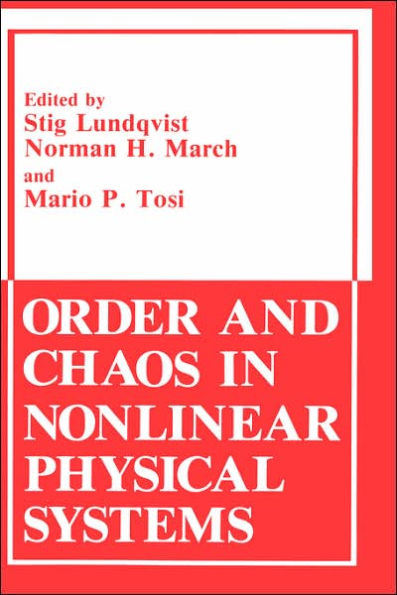Order and Chaos in Nonlinear Physical Systems
This volume is concerned with the theoretical description of patterns and instabilities and their relevance to physics, chemistry, and biology. More specifically, the theme of the work is the theory of nonlinear physical systems with emphasis on the mechanisms leading to the appearance of regular patterns of ordered behavior and chaotic patterns of shastic behavior. The aim is to present basic concepts and current problems from a variety of points of view. In spite of the emphasis on concepts, some effort has been made to bring together experimental observations and theoretical mechanisms to provide a basic understanding of the aspects of the behavior of nonlinear systems which have a measure of generality. Chaos theory has become a real challenge to physicists with very different interests and also in many other disciplines, of which astronomy, chemistry, medicine, meteorology, economics, and social theory are already embraced at the time of writing. The study of chaos-related phenomena has a truly interdisciplinary charac ter and makes use of important concepts and methods from other disciplines. As one important example, for the description of chaotic structures the branch of mathematics called fractal geometry (associated particularly with the name of Mandelbrot) has proved invaluable. For the discussion of the richness of ordered structures which appear, one relies on the theory of pattern recognition. It is relevant to mention that, to date, computer studies have greatly aided the analysis of theoretical models describing chaos.
"1014490623"
Order and Chaos in Nonlinear Physical Systems
This volume is concerned with the theoretical description of patterns and instabilities and their relevance to physics, chemistry, and biology. More specifically, the theme of the work is the theory of nonlinear physical systems with emphasis on the mechanisms leading to the appearance of regular patterns of ordered behavior and chaotic patterns of shastic behavior. The aim is to present basic concepts and current problems from a variety of points of view. In spite of the emphasis on concepts, some effort has been made to bring together experimental observations and theoretical mechanisms to provide a basic understanding of the aspects of the behavior of nonlinear systems which have a measure of generality. Chaos theory has become a real challenge to physicists with very different interests and also in many other disciplines, of which astronomy, chemistry, medicine, meteorology, economics, and social theory are already embraced at the time of writing. The study of chaos-related phenomena has a truly interdisciplinary charac ter and makes use of important concepts and methods from other disciplines. As one important example, for the description of chaotic structures the branch of mathematics called fractal geometry (associated particularly with the name of Mandelbrot) has proved invaluable. For the discussion of the richness of ordered structures which appear, one relies on the theory of pattern recognition. It is relevant to mention that, to date, computer studies have greatly aided the analysis of theoretical models describing chaos.
219.99
In Stock
5
1

Order and Chaos in Nonlinear Physical Systems
469
Order and Chaos in Nonlinear Physical Systems
469
219.99
In Stock

Product Details
| ISBN-13: | 9780306428470 |
|---|---|
| Publisher: | Springer US |
| Publication date: | 07/31/1988 |
| Series: | Physics of Solids and Liquids |
| Edition description: | 1988 |
| Pages: | 469 |
| Product dimensions: | 6.10(w) x 9.25(h) x 0.04(d) |
From the B&N Reads Blog
